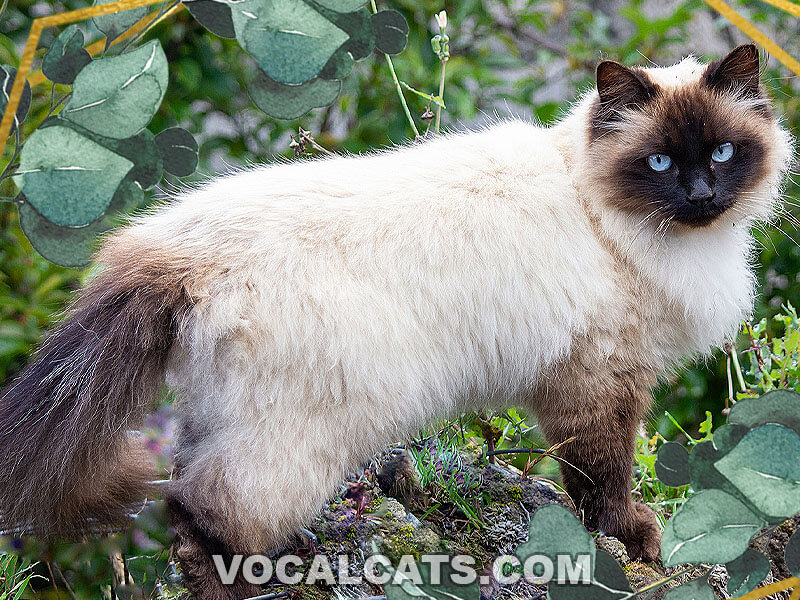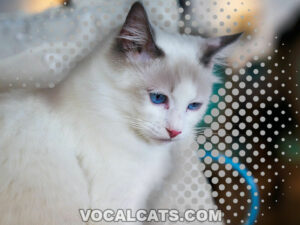If you’re looking for a loving, intelligent, and gentle feline, say hello to the Himalayan Siamese Cat. This relatively new color-point designer breed is on its way to becoming a popular choice for many in the cat community.
Himalayan Siamese can make a great addition to most households. But there’s more to this feline than meets the eye. For instance, the breed has specific diet and grooming concerns. The good news is this article will highlight all there is to this beautiful feline mix.
Much like the Snowshoe Siamese Mix, Himalayan Siamese cats might not always be easy to find, but we’ve covered that in this guide too. All you need to do is find a comfy seat and read on!
Contents
- Himalayan Siamese Cat: Breed overview
- What is a Himalayan Siamese Cat?
- Siamese Himalayan Cat parent breeds
- What two cats make a Himalayan?
- How do I know if my cat is a Himalayan Siamese?
- Himalayan Siamese genetics
- Siamese vs Himalayan Cat
- Are Himalayan Siamese Cats recognized by cat registries?
- Himalayan Cat Siamese physical appearance
- How big do Siamese Himalayan Cats get?
- Siamese Himalayan Mix size, height, and weight
- What color is a Himalayan Siamese?
- Siamese Mixed with Himalayan coat colors and types
- Himalayan Siamese Cat personality and temperament
- Do Himalayan Siamese Cats make great family pets?
- Himalayan Siamese Cat Mix training
- Siamese Himalayan Cat Mix exercise requirement
- Siamese and Himalayan Mix grooming and cleaning
- Do Himalayan Siamese Cats shed a lot?
- Are Siamese Himalayan Cats hypoallergenic?
- Siamese Himalayan Mix Cat food and diet
- Himalayan Siamese Mix common health issues
- Himalayan Siamese Cat lifespan
- Himalayan and Siamese Cat Mix breeders
- Siamese Himalayan kittens
- How much does a Himalayan Siamese cost?
- Himalayan Siamese Cat price
- Places to find Siamese Himalayan kittens for sale near me
- Finding a healthy Himalayan Siamese Cat for sale
- Similar Himalayan and Siamese Mix Cat
- Siamese Cats Mix with Himalayan: Pros and Cons
- Is the Siamese Himalayan Cat right for me?
- Related Questions
Himalayan Siamese Cat: Breed overview
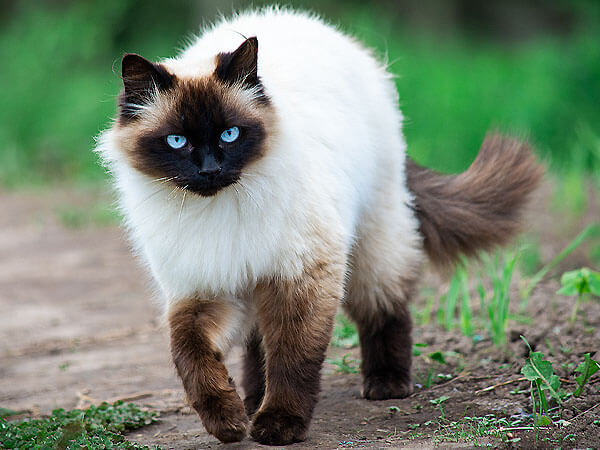
Our readers lead busy lives, so we’ve put together this quick facts section for folks on the go. Go through the table below to learn pertinent facts about the Himalayan Siamese breed without wasting too much time!
| Common Names | Siamese Himalayans |
| Size | Medium to Large |
| Weight | 7-13 pounds |
| Height | 10-14 inches |
| Lifespan | 8-12 years |
| Colors | Cream or ivory base color with seal, chocolate, flame, and lilac points |
| Child Friendliness | High |
| Feline Friendliness | High |
| Training Difficulty | Medium |
| Grooming Upkeep | Medium-to-High |
| Breed Health | Good |
| Exercise Needs | Medium |
| Kitten Costs | $700-$2,500 |
What is a Himalayan Siamese Cat?
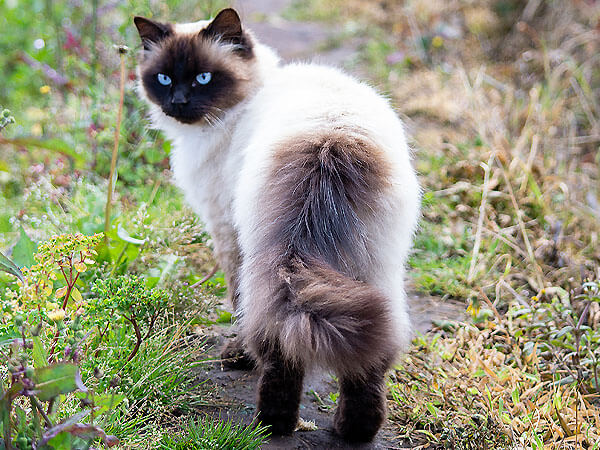
A Himalayan Siamese Cat is a crossbreed of the Siamese and Himalayan Feline breeds. It’s a relatively new hybrid with mysterious origins. However, the half Himalayan half Siamese Cat is gaining steady popularity, thanks to its good looks and friendly nature.
RECOMMENDED: Himalayan Maine Coon Mix (Complete Guide)
Siamese Himalayan Cat parent breeds
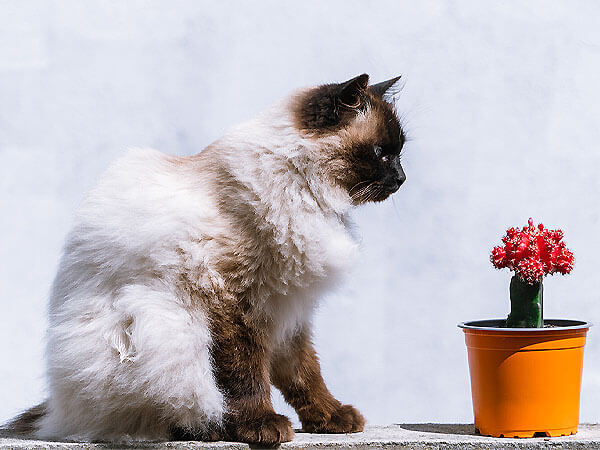
When we say the Siamese Himalayan cat is half Siamese half Himalayan, it means they’re hybrids of the two breeds. Put another way, they result from crossbreeding, meaning they’re not pure blood or pedigreed.
But, to truly understand the Siamese Himalayan hybrid, it’s best to learn about its parents’ histories. Scroll on to learn the origins of the Himalayan and Siamese breeds.
Siamese Cat origin
Siamese cats are among the world’s oldest and most recognized cat breeds. The origin of Siamese cats can be traced back to ancient Siam, now known as Thailand.
According to historical records, Siamese cats were first mentioned in a manuscript called the ‘Tamra Maew,’ written in the 14th century. The manuscript describes the physical appearance and personality traits of Siamese cats and states these felines were considered sacred in ancient Siam.
Siamese cats were treasured by the royal family in Siam, and only the king and his family were allowed to own them. They were considered a symbol of good luck and were gifted to foreign dignitaries.
In the late 1800s, Siamese cats found their way to the Western world, and their unique appearance and personality quickly gained popularity. The first Siamese cats were brought to England by a British diplomat and were exhibited in cat shows, with their striking blue eyes and sleek, muscular bodies captivating audiences.
Today, Siamese cats are known for their distinctive appearance, intelligence, and playful personality. They are a popular breed worldwide, and their origins in ancient Siam continue to fascinate cat enthusiasts and historians alike. Siamese have come a long way from their sacred status in Siam, but their beauty and charm remain as captivating as ever.
CHECK OUT: Siamese Ragdoll Cat (Ragamese Complete Guide)
Himalayan Cat history
The Himalayan cat, also known as the Himalayan Persian, originated in the United States in the early 1930s. It is a cross between the Persian and Siamese cats. This breed was created to combine the Persian’s beautiful long-hair coat with the Siamese’s distinctive color points.
The Himalayan cat was named after the Himalayan mountains because it resembles the Himalayan rabbit, which surprisingly also has color points. By 1935, Himalayans had found their way to the British Isles, and steadily their popularity grew as people became fascinated with their looks and gentle nature.
While the Cat Fanciers’ Association officially recognized Himalayans as a breed in 1957, the breed was further refined in the 80s, resulting in a more distinct appearance and a wider range of coat colors. Modern-day Himalayans are known for their sweet and affectionate personality, as well as their impressive appearance.
What two cats make a Himalayan?
Himalayan cats are a hybrid of Persians and Siamese cats. That’s why Himalayans are often referred to as the Himalayan Persian breed. The existence of this cat breed is no accident. In fact, breeders specifically created this breed to combine the silky long-haired coat of Persian cats with the color-point of Siamese.
How do I know if my cat is a Himalayan Siamese?
Seeing as how Himalayan cats also carry Siamese genes, telling them apart from the Himalayan Siamese can be a bit tricky.
However, on the whole, the facial features and body structure of Himalayans generally take after Persian cats. Conversely, a Himalayan Mixed Cat will inherit traits from its Himalayan and Siamese parents, which means you’ll likely see a greater resemblance between this mixed breed and Siamese cats.
For instance, since the long-hair gene in cats is recessive, a kitten must inherit two copies of the gene (from both parents) to have a long coat. However, since Siamese cats are short-haired, while Himalayans are long-haired, Himalayan Siamese cats can inherit the trademark Siamese short-hair coat.
Here’s the thing, though, if there was inbreeding, as in kittens of the same litter were to breed, it’s possible their offspring would grow on to become long-hair cats.
Another distinction between Himalayans and Siamese Himalayans can be body type. You can expect some kittens to inherit the long and sleek body of the Siamese cat and have more angular facial features.
READ NEXT: Maine Coon Siamese Mix (Complete Guide)
Himalayan Siamese genetics
As stated earlier, the long-hair gene in cats is recessive. That means first-generation Himalayan Siamese will likely be short-hair kittens.
Nonetheless, if two Siamese Himalayan felines of the same batch were to breed, their kittens may be long-haired Himalayan Siamese on account of being carriers of the long-hair gene.
Besides that, the colorpoint or cs gene is also recessive.
However, since both Himalayans and Siamese cats are color-point breeds, their kittens have much greater chances of inheriting this hallmark coat pattern.
Finally, since both the parents of Himalayan Siamese cats are color-point cats, they will likely always have blue eyes, which is associated with the color-point pattern.
DON’T MISS: Russian Blue Mixed with Siamese (Complete Guide)
Siamese vs Himalayan Cat
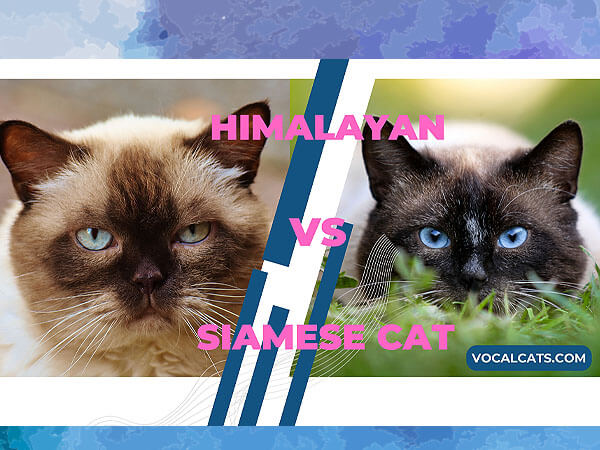
The main difference between Siamese and Himalayan Cats is that Siamese Cats are purebred while Himalayan Cats are a hybrid of Persians and Siamese cats. Aside from that, there are various physical differences between the two feline types.
For example, Himalayans generally take after Persians regarding body type; they appear fluffy due to their long-hair coats, have round eyes, and almost flat faces.
On the flip side, Siamese cats have a more elongated appearance due to their sleep physique, have short coats, and have triangular faces with prominent noses.
Are Himalayan Siamese Cats recognized by cat registries?
While Himalayan and Siamese cats are recognized by cat registries worldwide, the same can’t be said of Himalayan Siamese Cats.
There are several reasons why cat registries don’t take up designer breeds. There is much debate over whether cat registries should officially recognize mixed cat breeds.
Some argue that recognizing mixed breeds could increase inbreeding and contribute to feline overpopulation. Others state that mixed breeds should be acknowledged for their unique qualities and deserve recognition as much as purebred cats.
Despite the controversy surrounding mixed breeds, some cat registries have started to recognize them officially. The International Cat Association (TICA) allows mixed breeds to compete in their shows under the ‘New Breeds and Colors’ (NBC) category.
The Himalayan Siamese breed may come to be recognized officially some years down the line, but they don’t have that status currently.
Himalayan Cat Siamese physical appearance
The Himalayan Cat Siamese hybrid can vary in appearance depending on its parentage. To begin with, if the kittens come from crossbreeding Siamese and Himalayan sires and dams, they will likely not be long-haired cats.
Although, if the kittens result from Himalayan Siamese parents, they have higher chances of inheriting the luxurious coat of their Himalayan feline ancestors. The one constant about this designer breed is its color-point pattern.
Color-points are a distinctive feline type known for their stunning coat colors and patterns. These felines are characterized by their light-colored bodies with dark points on their face, ears, legs, and tail. The points can come in various colors, such as chocolate, blue, and lilac.
Regarding the facial features of the Himalayan Cat and Siamese designer breed, kittens can take after either parent breed. They can inherit the triangular face and ears of the Siamese or the softer, more rounded countenance of Persians.
But there’s one thing all Himalayan Mix Cat(s) will have, and that’s their beautiful, clear-as-sky, blue eyes.
How big do Siamese Himalayan Cats get?
You can expect a Himalayan cross Siamese Cat to weigh anywhere between eight to twelve pounds. If your kitten’s bloodline contains a champion Himalayan male, it’s possible your kitten can cross the 12-pound threshold, but this is pretty rare.
Siamese Himalayan Mix size, height, and weight
Knowing your fur baby’s measurements can go a long way in making the lives of cat parents easier.
Think about it; you’ll need to know how big your Himalayan Mixed with Siamese feline grows to determine if your household is a good fit for it.
Moreover, you’ll need size dimensions to prepare for the arrival of your pet and know when it’s time for an upgrade.
That’s why this section will walk you through what you can expect of the Siamese Himalayan Mix when it comes to size, height, and weight of the breed, according to gender.
| Height | Weight | Length | |
| Male | 12-14 inches | 10-13 pounds | 12-15 inches |
| Female | 10-12 inches | 7-10 pounds | 10-12 inches |
What color is a Himalayan Siamese?
The base color of a Himalayan Siamese cross is typically very light and can range from ivory to beige. But, these cats can inherit varying color points from their parent breeds.
For instance, seal (dark brown), chocolate, lilac, red, and blue color points are common in both Himalayans and Siamese cats.
Siamese Mixed with Himalayan coat colors and types
Though we discussed the colors of a Siamese Mixed with Himalayan mix above, this section is for you if you’re looking for a more in-depth approach. Scroll below to learn the variety of colors you might encounter in the Siamese and Himalayan hybrid.
Blue Himalayan Siamese Cat
You can expect a Blue Himalayan Siamese Cat to have a cool grey or bluish-ivory base color. The nose leather and paws of these cats are a darker blue, along with similarly shaded points on the ears, nose, feet, and tail.
Flame point Siamese Himalayan
Flame-point Siamese Himalayan cats have a cream base color with reddish or orange points. The points can vary in hue from pale pink to chestnut. The nose leather and paw pads of these cats are generally coral pink.
Seal point Siamese Himalayan
Seal-point Himalayan Siamese cats have a beige base color with very dark brown points. Their tips are so heavily shaded that they can appear almost black in low-light situations. The paw pads and nose leather of seal points are dark brown too.
Himalayan shorthair Cat
A Himalayan short hair can inherit any of the colors of its parent breeds but will typically sport a short-hair coat similar to Siamese cats. These cats don’t require half the grooming time as their long-haired counterparts and resemble their Siamese ancestors in looks.
Himalayan Siamese Cat fluffy
The Himalayan long hair Himalayan Siamese Cat, as the name suggests, inherits the luxurious fluffy coat of the Himalayan and Persian cats. You can expect your long hair Himalayan Siamese Cat to inherit one of the various color combinations of this hybrid breed. Still, your fur baby will typically resemble its Himalayan feline relatives more.
Himalayan Siamese Cat personality and temperament
Now that we’ve covered coats and colors let’s move on to Himalayan Siamese Cat personality details. A Siamese Cat and Himalayan mix will be gentle and docile but may experience short bursts of energy from time to time.
Since these cats are a hybrid of Siamese and Himalayan breeds, you can expect your kitten and adult cat to show you plenty of affection. It’s not uncommon for these felines to sleep in bed with their owners and cuddle in your lap for a quick nap.
Another exciting aspect of the Siamese Himalayan Mix Cat personality is the designer breed’s intelligence. But, like most animals with lots of smarts, you may find them challenging to train at first.
Finally, thanks to the unaggressive nature of the Siamese Himalayan Mix personality, you don’t have to worry about this breed getting into trouble with other animals and pets.
Do Himalayan Siamese Cats make great family pets?
Himalayan Siamese Cats are playful and active but have a peaceful and gentle nature, making them great companions for families with children. The Siamese Cat Himalayan mix doesn’t mind being around people and enjoys spending time curled up on its parent’s lap. These felines are also social with other cats and dogs, making them a great addition to households with multiple pets.
Himalayan Siamese Cat Mix training
The Himalayan Siamese Cat Mix is known for its striking appearance, intelligence, and playful nature. However, they can also be quite stubborn, making training a crucial part of their development. Here are some pro tips to aid you in training your Siamese Himalayan feline.
First, it is essential to start training your pet at a young age. A Himalayan Siamese kitten tends to develop behavioral patterns early on, so consistent training can help establish good habits. Positive reinforcement is a practical training technique for these cats.
Reward your pet with treats when they exhibit good behavior. Himalayan Siamese kittens are intelligent and will pick up on training quickly if you are consistent and patient.
Secondly, socialization is also crucial for this designer breed. These cats thrive on human interaction and can get lonely if left alone for long.
Expose your cat to different environments, people, and animals to help them become well-adjusted. Providing your fur baby with toys and activities is essential to keep them mentally stimulated. Regular playtime can help your cat burn off energy and reduce bad behavior.
Siamese Himalayan Cat Mix exercise requirement
A Siamese Himalayan Cat Mix can inherit one of two body types from its parent breeds. They can resemble Himalayan cats or take on the physique of sleek Siamese felines. Still, no matter your fur baby’s body structure, regular exercise is a must to avoid problems like being overweight.
Before you get too anxious, your Siamese Himalayan cross won’t require you to take on jogging jaunts. However, you will have to take at least 10-15 minutes daily to play with your fur baby to burn off excess energy and keep obesity-related health concerns away.
You can rely on interactive toys or feather teasers to keep your feline on its toes and combine playtime and exercise together.
Siamese and Himalayan Mix grooming and cleaning
How much time and effort you have to spend grooming and cleaning your Siamese and Himalayan Mix can vary depending on your kitty cat. For example, if your kitten is of the long-haired variety, you’ll undoubtedly need to brush it more often.
However, if you own a short-hair Siamese x Himalayan mix, you’ll still need to pay attention to caretaking details like nail clipping, ear/eye cleaning, and bathing. The table below will help you understand the frequency of each grooming requirement.
| Grooming Technique | Frequency |
| Hair Brushing | 10-20 mins daily (for long-haired cats), 5 mins daily (for short-haired felines) |
| Bathing | Once a month or as needed. |
| Nail Trimming | Once every three to four weeks. |
| Teeth Brushing | Daily teeth brushing. |
| Eye Care | Wipe eye crusts as required or once every two days. |
| Ear Care | Wipe ears when necessary. |
Do Himalayan Siamese Cats shed a lot?
Long-haired Himalayan Siamese Cats are known for their gorgeous, fluffy coats. This also means these felines can experience moderate to heavy shedding. Himalayan x Siamese cats shed their fur throughout the year but tend to shed more heavily during the spring and fall when they drop their winter or summer coats.
It is important to note that shedding is a natural process for cats, and it helps them to get rid of dead and damaged hair.
However, excessive shedding can indicate an underlying health issue or poor nutrition. Regular grooming habits can help to reduce the amount of fur your pet sheds and keep their coat looking healthy and shiny.
Also, you should note that short-haired Siamese Himalayans will not experience as much shedding as their long-haired counterparts. These felines are also low maintenance when it comes to brushing and bathing.
If you have your heart set on acquiring a long-haired feline pet, you can control the side effects of shedding to quite an extent with gadgets like vacuum cleaners with HEPA filters to help purify the air of fur and dander.
Are Siamese Himalayan Cats hypoallergenic?
Does your Google search history include the term ‘ Are Siamese Himalayan Cats hypoallergenic?’ The answer to this question is it all depends on whether your pet is long or short-haired.
As stated earlier, short-haired Himalayan Siamese cats don’t shed as much as long-haired ones. But, if you or anyone in your home has feline allergies, it’s a good idea to invest in an air purifier with HEPA filter to effectively trap fur, dust, feline dander, and other allergens.
Siamese Himalayan Mix Cat food and diet
If you are a proud Siamese Himalayan mix cat owner, you must know their specific dietary needs. The Himalayan x Siamese Cat is prone to obesity, so providing them with a well-balanced diet that includes high-quality protein, healthy fats, and moderate carbohydrates is crucial.
When choosing cat food for your Siamese Himalayan mix, look for formulas that contain real meat as the first ingredient, and avoid fillers like corn, wheat, and soy. Wet food is another good option as it helps to keep your cat hydrated and supports their urinary tract health.
As for Siamese and Himalayan Mix kittens, it’s always best to confer with your vet about the diet of young pets. That’s because the nutritional needs of kittens aren’t like adult felines. Kittens require high-protein food because they have a lot of growing up to do.
Himalayan Siamese Mix common health issues
Himalayan Siamese Mix cats are a relatively healthy breed, but like all cats, they can be prone to certain health issues.
Whether you have a mixed cat breed (like the Himalayan Siamese Mix) or a purebred, using a cat DNA test kit is essential. This test kit allows you to find out your cat’s breed-specific traits, genetic makeup, and health conditions they may be predisposed to.
In the meantime, here are seven (7) common Himalayan Cat health issues cat parents should know about.
Respiratory infections
Himalayan Siamese Mix cats are prone to respiratory infections, especially in their kittenhood. That’s why it’s vital to complete your Siamese Himalayan kitten’s vaccinations as soon as possible.
Dental problems
Siamese Himalayans may have dental problems such as gum disease and tooth decay if their oral health is ignored. It is paramount to keep their teeth clean and provide them with proper dental care from an early age.
Eye problems
Himalayan Siamese cats may develop eye problems such as conjunctivitis, cataracts, and glaucoma.
Kidney disease
This breed is prone to kidney disease, which can be linked to factors like genes,, age, and diet.
Urinary tract infections
Himalayan Siamese Mix cats may be prone to urinary tract infections (UTIs). Like an infection, a UTI can result from problems with genetics, diet, or anxiety.
Obesity
These cats can become obese if they are overfed or do not get enough exercise.
Heart disease
Himalayan Siamese Mix cats may develop heart disease due to genetics and age. That’s why cat parents must regularly take their Himalayan Siamese cat to the vet. A clockwork veterinarian schedule can also go a long way in early detection.
Himalayan Siamese Cat lifespan
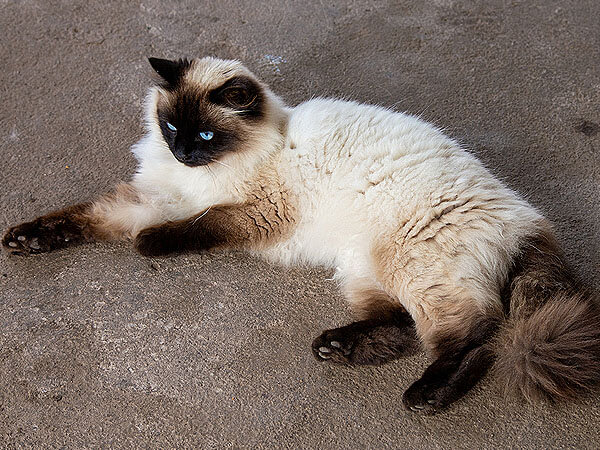
The average life of Himalayan Siamese Cats spans between eight to twelve years. However, readers should note that this is more of a general guideline. How much longevity your pet will enjoy depends on various factors like nutrition, health conditions, etc.
Himalayan and Siamese Cat Mix breeders
When trying to bring home your own Himalayan and Siamese Cat Mix, it’s best not to rely on pet stores. Instead, contact reputable breeders in your area to acquire your kitten. If you’re wondering why, it’s simple.
Feline breeders are meticulous about health testing dames and sires and follow established industry practices and ethics. That means you have a much better chance of acquiring a healthy kitten, complete with early vaccinations, litter training, and health guarantees.
Siamese Himalayan kittens
When bringing Siamese Himalayan Mix kittens home, always remember to kitten-proof your home, among other preps.
For example, hide wires and cables out of sight, block any hard-to-reach crevices where your kitten can venture, invest in a pet gate for your stairways, etc.
You’ll want to tackle any situation you think may be potentially harmful to your little fur baby and proof your surroundings accordingly.
How much does a Himalayan Siamese cost?
A Himalayan Siamese cat can cost anywhere from $700 to $2,500 depending on where you’re located, the breeder you pick, the availability of kittens, their color and coat types, etc.
If you’re wondering why the Siamese Himalayan Cat price seems pricier than other cats, it’s because the designer breed is relatively new.
If demand keeps growing without a correlating number of breeders, this rareness situation will push the Himalayan Siamese Mix price to quite an extent.
Besides that, if the kittens acquire a rare color combination, the Himalayan Siamese price can go up or down depending on how unique the coloring is.
Himalayan Siamese Cat price
Here’s a quick breakdown of the initial costs you might experience when you bring your fur baby home.
| Expense Type | Cost |
| Cat food and treats | $30-$60 |
| Bowls for food and water | $15-$25 |
| Cat bed | $15-$40 |
| Carrier | $35-65 |
| Litter tray | $60-$150 |
| Litter | $10-$35 |
| Grooming items | $20-$45 |
| Toys | $15-$50 |
| ID Tag | $15-$20 |
| Vet visits (initial) | $150-$300 |
| Initial shots | $25-$50 |
| Medications (flea, heartworm, etc.) | $45-$150 |
| Neuter/spay procedure | $45-$500 |
| Microchip | $40-60 |
| Initial cost (total) | $520-$1,550 |
Places to find Siamese Himalayan kittens for sale near me
Let’s be honest. Sometimes, Google doesn’t yield great results for the ‘Siamese Himalayan kitten for sale near me’ query. But that’s okay; we’ve lined up some great breeders you can start your Himalayan Siamese kittens for sale search with!
A Kitkat Cattery (akitkathaven.com/available.shtml)
If you’re looking for Siamese Himalayan kittens for sale in California, take a moment to check out the Kitkat Cattery. Sue Swaim manages the establishment and deals with Himalayan, Persian, and Scottish Fold breeds. Their kittens come from Grand Champion, National, and Regional Winner lines.
Tresor Siamese Cats (tresorsiamesecats.com)
This enterprise specializes in Balinese and Siamese felines. They’re TICA and CFA registered and home-raise all their Siamese Himalayan Mix kittens for sale with meticulous care. All their kittens are litter trained and have received early vaccination shots before they’re sent to their fur-ever homes.
PuffStuff Cattery (puffstuffcats.com)
PuffStuff deals in Himalayans and color-point exotics like Persians, etc. They’re CFA registered and CFA breed council members. If you’re on the lookout for your Himalayan Siamese kitten and will settle for nothing but the best, this is a good place to start.
Finding a healthy Himalayan Siamese Cat for sale
Suppose you’re searching for an adult Himalayan Siamese Cat for sale; this section is for you. While the entries here may not have a Siamese Himalayan Cat for sale, they’ll help locate the feline of your dreams.
Victorian Gardens Cattery (victoriangardenscattery.com)
Victorian Gardens Cattery is CFA-registered and specializes in Himalayan and Persian cats and kittens. They have an excellent collection of pedigreed cats that anyone would love to have. That’s why this establishment is featured at the top of our list for readers searching for Siamese Himalayan Cats for sale.
READ ALSO: Maine Coon Mixed With Persian (Complete Guide)
Black Thai Cattery (blackthaicattery.com)
If you’re looking for a home-raised Himalayan Siamese Mix Cat for sale, try contacting Black Thai Cattery. The cattery is TICA registered and has several Siamese adults for sale; they’re a good place to start enquiring about Siamese Himalayan Mix for sale because of their experience in the breeding arena.
Similar Himalayan and Siamese Mix Cat
Sure, the Himalayan and Siamese Mix Cat is a designer breed, but are there any hybrids of this hybrid? That’s precisely what we’ll be discussing in this section!
Ragdoll Siamese Ragdoll Himalayan Cat
As the name makes clear, the Siamese Himalayan Ragdoll is a cross-breed of the Siamese Himalayan cat and the Ragdoll breed. These felines are long-haired lookers and tend to resemble Ragdolls and Himalayans.
The Himalayan Ragdoll Siamese Mix isn’t very easily available, however. Seeing as how this is a hybrid of a reasonably new designer breed, locating Himalayan Ragdoll Siamese kittens may be a challenge.
Himalayan Persian Siamese Cat
The Siamese Himalayan Persian Cat is a hybrid of Siamese-Himalayan and Persian breeds. Much like the above-mentioned designer breed of Siamese Himalayan Ragdolls, the Siamese Persian Himalayan are generally long-haired and fluffy.
READ ALSO: Persian Ragdoll Cat (Complete Guide)
Siamese Cats Mix with Himalayan: Pros and Cons
The Siamese Cats Mix with Himalayan can make an excellent addition to any household. But, if you still have lingering doubts about what’s right for you, go through our pros and cons list below.
| Pros | Cons |
| Gentle | Can be high shedders |
| Playful | Difficult to acquire |
| Good with kids | Must be kept indoors |
| Good with pets | Prone to certain health conditions |
| Intelligent | Can suffer from anxiety if left alone for long |
| Likes spending time with humans | Can be demanding in terms of attention |
Is the Siamese Himalayan Cat right for me?
If you are considering getting a Siamese Himalayan cat, it is essential to consider whether or not this feline breed is the right for you. Siamese Himalayans are often described as social and playful and enjoy interacting with their owners.
However, they can also be vocal and demanding of attention, so it’s important to have the time and energy to devote to them.
Additionally, long-haired Himalayan Siamese require regular grooming to prevent matting and tangling. Before bringing a Siamese Himalayan cat into your home, carefully evaluate your lifestyle and living situation to ensure you can provide the love and care this breed requires.
Related Questions
Himalayan cats are a cross-breed of Persians and Siamese cats. That means they tend to resemble both their parent breeds.
DISCLAIMER: THIS WEBSITE DOES NOT PROVIDE MEDICAL ADVICE
The information, including but not limited to, text, graphics, images and other material contained on this website are for informational purposes only. No material on this site is intended to be a substitute for professional veterinary advice, diagnosis, or treatment. Always seek the advice of your veterinarian or other qualified health care provider with any questions you may have regarding a medical condition.

With over five years of specialized experience as an animal writer, my expertise lies in cat nutrition, health, behavior, grooming, and training. I am dedicated to delivering helpful and informative content that caters to the well-being of our feline friends. My primary goal is to empower pet owners with knowledge and ensure our feline companions thrive in health and happiness. In my free time, I love volunteering at local cat rescue centers.
